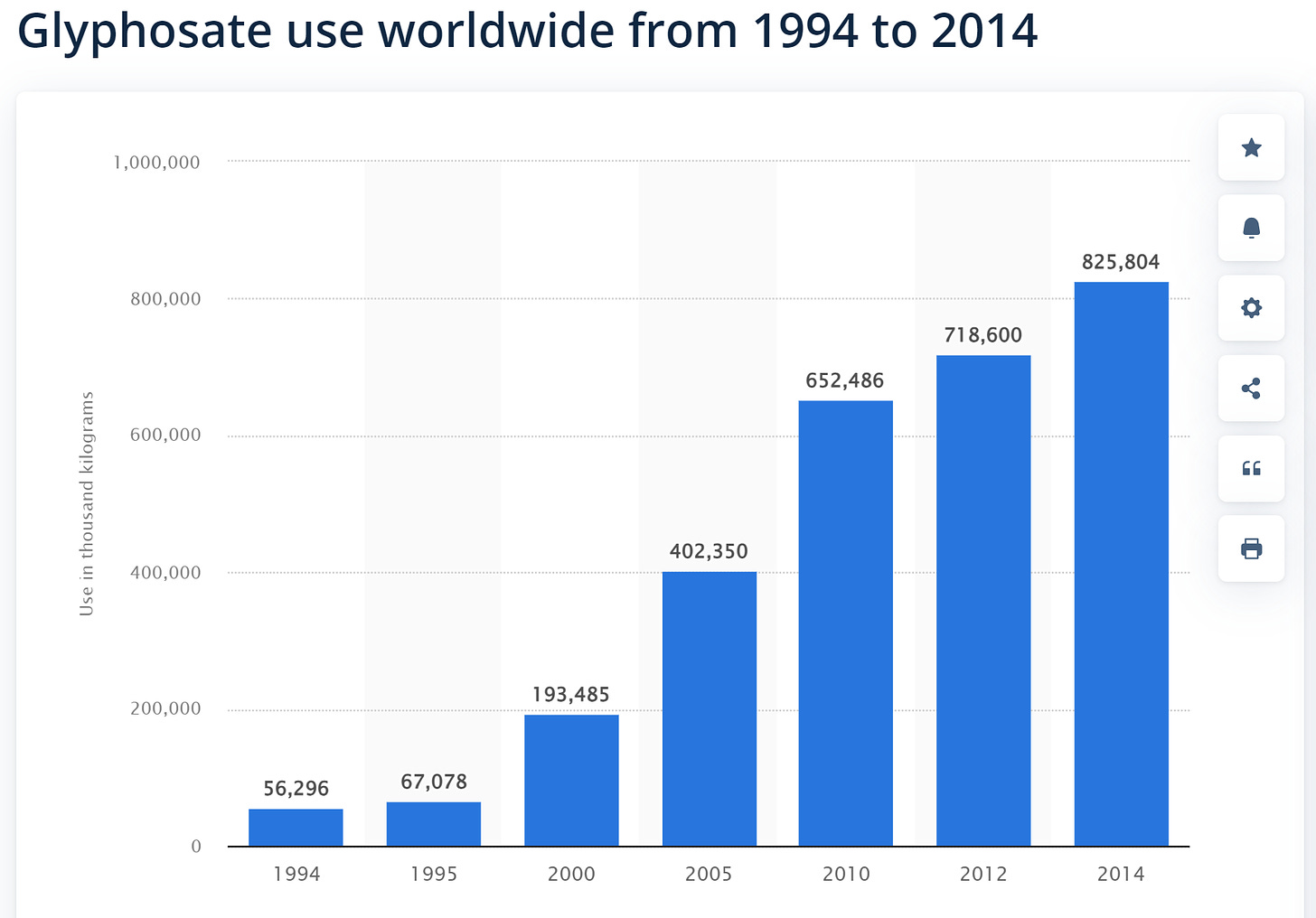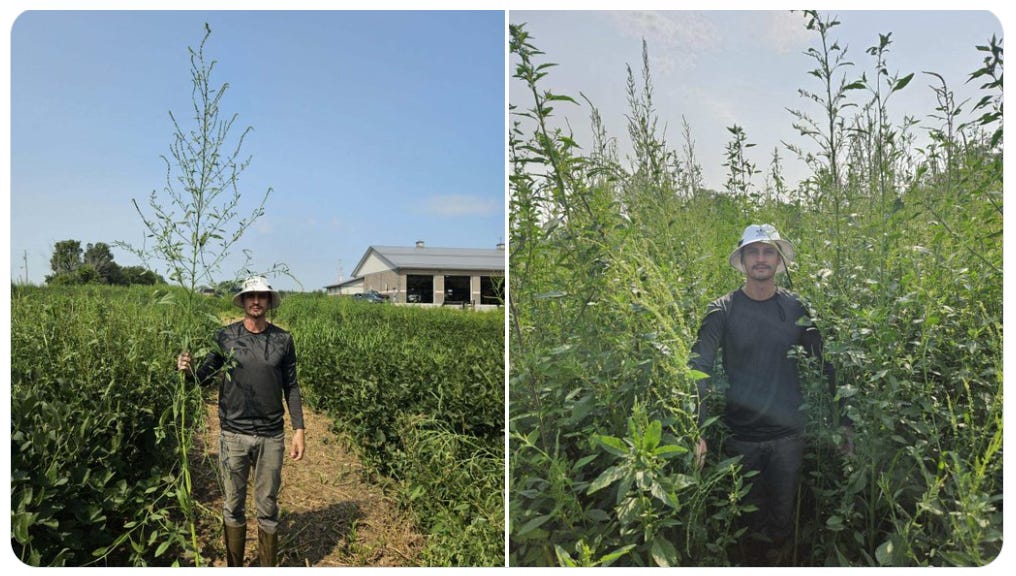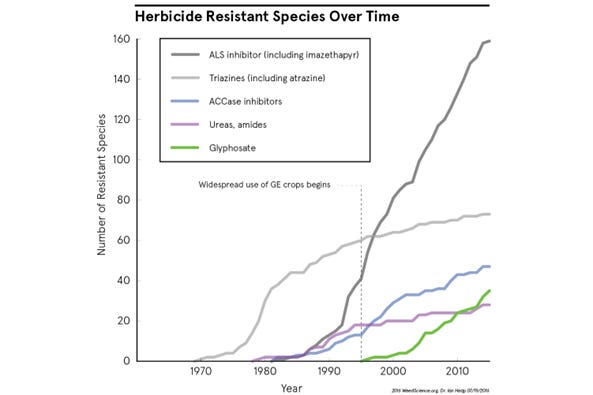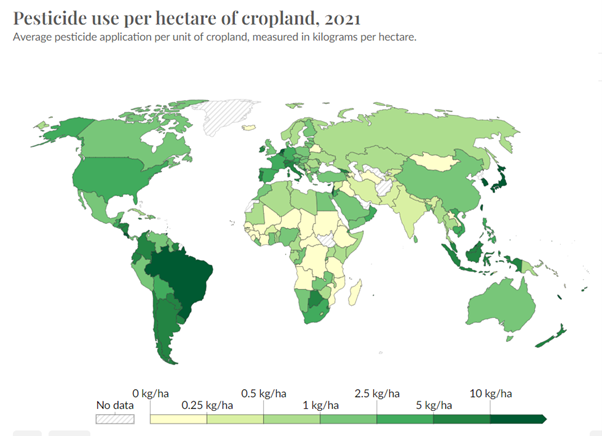159 | Spotlight on Shigella | Superweeds (Super Bad) | Loving Fakes |
Plus, an unusual food source for a Listeria outbreak
Spotlight on Shigella;
Superweeds (super bad);
Food Safety News and Resources;
Why people knowingly buy fakes;
Food fraud news, emerging risks and recent incidents.
Question: My country’s regulatory agency is calling for feedback about a proposal to seek approval for the sale of food derived from sugar beet genetically modified to tolerate the herbicides dicamba, glufosinate and glyphosate. Why?!???
Why why why are we still developing herbicide resistant crops when the widespread use of herbicide is causing a massive superweed problem? Surely there’s a better way to handle weeds?
Hi, welcome to Issue 159 of The Rotten Apple where I talk superweeds, Shigella and the mindset behind purchasing fakes. A special welcome and shoutout to 👏👏Lisa 👏👏 who became a paying subscriber last week. I rely on the support of readers like Lisa to enable me to produce this newsletter each week. Thank you.
Also this week, our food safety news and resources section has some interesting items, including an unusual food vector for a Listeria outbreak and an unusual supplement-related poisoning.
Have a wonderful week,
Karen
P.S. If you love this newsletter, please tell your friends and colleagues about it and help grow our community of global food safety champions.
Spotlight on Shigella
You don’t often hear about Shigella outbreaks, but one is happening in the USA right now. Read about that in this week’s food safety news roundup.

The only natural reservoir for Shigellae species is humans and no food products naturally harbour Shigella bacteria, making this foodborne pathogen quite different from other bacterial pathogens like Listeria and Clostridium botulinum which are ubiquitous in the environment.
In practice, this means that Listeria and other ubiquitous bacteria are almost guaranteed to be present in raw foods and soil, while Shigellae are only found in environments or foods that have been contaminated with human faecal matter.
Shigella has a low infective dose (10 to 100 organisms) and can survive in refrigerated and frozen foods. Some species are also acid tolerant, especially at refrigerator temperatures, and mildly salt tolerant. Shigella is better at surviving stomach acid than many other bacteria.
When ingested, Shigella causes severe symptoms which last for around 7 days and include bloody diarrhoea, fever and abdominal cramps. Secondary complications such as bacteremia and hemolytic uremic syndrome (HUS) can be life-threatening.
Shigellosis is a major cause of bacteria-caused dysentery (bacillary dysentery) worldwide. There are 1.1 million deaths from shigellosis worldwide each year, primarily of children in developing countries, with most cases caused by person-to-person transmission and contaminated water. In the United States, just 1% to 6% of outbreaks are foodborne.
Foodborne outbreaks in wealthy countries are usually traced to an infected food handler who has contaminated food through the faecal-oral route – that is, they have not washed their hands properly after using the toilet – however, foods that are eaten raw and which have been contaminated with human waste prior to harvest can also cause illness.
Commonly implicated foods are those that have been prepared by hand and eaten raw, such as salads, with outbreaks occurring in restaurants, social gatherings, airlines and cruise ships.
In wealthy countries, foodborne Shigella outbreaks are easy to prevent. The bacteria are destroyed rapidly at 65°C (149°F). Prevention relies on two principles: careful food sourcing and hand hygiene. In countries where Shigella is endemic, avoid raw food and drink only boiled or commercially bottled water.
Takeaways for food professionals
Shigella is a group of four species of bacteria that can cause foodborne illness but which more commonly cause illness through person-to-person transmission and contaminated water. Shigellae survive in frozen and refrigerated foods.
To control and prevent risks from Shigella:
Foods that will be served raw must be sourced carefully to ensure they have not been contaminated with human waste during growing, harvesting, packing or processing
Any person handling food must follow hygiene protocols including thorough and effective hand washing and avoiding bare hand contact with ready-to-eat foods.
In short: Shigella does not occur naturally in food or the environment, its natural reservoir is humans 🍏 Food only becomes contaminated with Shigella through contact with human waste, either during growing or from unhygienic handling practices via the faecal-oral route 🍏 Most Shigella infections are not from food 🍏Shigella survives in refrigerated and frozen foods and some species are acid and salt tolerant 🍏 Cooking inactivates Shigella 🍏 Infections typically present with severe gastrointestinal symptoms and bacteremia and hemolytic uremic syndrome (HUS) can result 🍏 Prevention is achieved by sourcing uncontaminated ready-to-eat foods and good hand hygiene 🍏
Sources:
Aslam, A. and Okafor, C.N. (2022). Shigella (Shigellosis). [online] PubMed. Available at: https://www.ncbi.nlm.nih.gov/books/NBK482337/.
Food Standards Australia New Zealand (2013) Shigella species. Available at: https://www.foodstandards.gov.au/sites/default/files/publications/Documents/Shigella%20species%20-%20dec%202013.pdf
NSW Health (2022). Shigellosis fact sheet - Fact sheets. [online] Available at: https://www.health.nsw.gov.au/Infectious/factsheets/Pages/shigellosis.aspx
NYGREN, B.L., SCHILLING, K.A., BLANTON, E.M., SILK, B.J., COLE, D.J. and MINTZ, E.D. (2012). Foodborne outbreaks of shigellosis in the USA, 1998–2008. Epidemiology and Infection, [online] 141(02), pp.233–241. doi:https://doi.org/10.1017/s0950268812000222.
PennState Extension (2024) Shigella: A Food Safety Concern. [online] Available at: https://extension.psu.edu/shigella-a-food-safety-concern
Sciencedirect.com. (2015). Shigella - an overview | ScienceDirect Topics. [online] Available at: https://www.sciencedirect.com/topics/agricultural-and-biological-sciences/shigella.
West Virginia Department of Health and Human Resources (2007) Shigellosis Surveillance Protocol. Available at: https://oeps.wv.gov/shigellosis/documents/lhd/Shigella_Protocol.pdf
Superweeds: A Threat to Food Production
Back in March 2023 I wrote about glyphosate in this newsletter. It’s one of my most widely read posts. I reminisced about spraying glyphosate-containing Roundup herbicide on weeds on my friend’s farm as a teenager in the 1980s and shared my surprise at just how much our usage of - and reliance on - this mega chemical has increased in the decades since.
Glyphosate was used a lot in the 1980s. It’s used a lot more now. A LOT more. In the US its use in agriculture increased by 3,153% from 1990 to 2014, (yes, three thousand percent).

Shockingly, this most widely used agricultural chemical of all time has progressed from a simple weed killer to a crop desiccant, used to dry out food crops like wheat, oats and beans just before harvest to kill the leafy parts of the crop and allow for easier harvesting.
Perhaps as a result, the proportion of US residents with detectable levels of glyphosate in their bodies has increased from 12 percent in 1990 to 100 percent in 2020.
Many scientists believe glyphosate poses risks to food consumers, with the International Agency for Research on Cancer (IARC) classifying it as “probably carcinogenic to humans (Group 2A).” Even the scientists who were part of glyphosate’s early safety approvals expressed their dismay about the chemical. Their opinion that glyphosate was unsafe for use as a herbicide was overturned by senior management at the US EPA in 1984.
At the time of my post in March 2023, which came soon after the IARC cancer determination, a European ban on glyphosate seemed likely - or at least possible. However, a few months later, in July 2023, the European Food Safety Authority (EFSA) said glyphosate is safe, or more accurately, “The [our] assessment of the impact of glyphosate on the health of humans, animals and the environment did not identify critical areas of concern.” A few months after that, in December 2023, the European Commission renewed its approval of glyphosate until 2033.
So the official word is that glyphosate is safe for food consumers.
But it’s proving problematic in other ways. Like its contribution to the emergence of superweeds.
What are superweeds?
Superweeds are fast-growing, non-crop plants that have developed natural resistance to commonly used herbicides, such as glyphosate (Roundup). This evolved resistance allows them to survive herbicides used to control weeds in and around commercially important crops.

First observed in 1957, herbicide resistance has now been detected in 273 plants worldwide, including:
· Palmer Amaranth (Amaranthus palmeri). Notorious for its rapid growth and high seed production, Palmer amaranth has developed resistance to multiple herbicide classes, including glyphosate.
· Waterhemp (Amaranthus tuberculatus). Similar to Palmer amaranth, waterhemp has shown resistance to several herbicides, making it a major problem in corn and soybean fields.
· Horseweed (Conyza canadensis). Also known as marestail, horseweed is resistant to glyphosate and other herbicides and can be particularly challenging to control in no-till systems.
· Kochia (Kochia scoparia). Kochia has developed resistance to multiple herbicides, including glyphosate and dicamba, and is a significant issue in the western United States.
· Ragweed (Ambrosia artemisiifolia). Common ragweed, particularly resistant to glyphosate, poses problems in agricultural fields and along roadsides.
Superweeds are becoming increasingly prevalent due to the extensive use of herbicides, which exerts a strong evolutionary pressure on the weeds to develop resistance.
Superweeds threaten agricultural land, conservation areas and waterways. In food production, superweeds pose challenges for farmers, as they reduce crop yields and increase production costs.
How to make a superweed
To make superweeds, apply severe evolutionary pressure to ordinary weeds, by using a lot of herbicide. Most genetic variants of the weed will die, but the few individuals with genes which impart some resistance will survive and continue to breed.
Repeat the cycle: more herbicide, more evolutionary pressure, more weed breeding cycles, and soon you will have superweeds which can survive exposure to the herbicide.
Glyphosate is the most widely used herbicide globally. It is sprayed onto genetically modified (GM) crops, which are engineered to be resistant to glyphosate so that farmers can eliminate weeds by broadcasting the herbicide across a whole field without damaging the crop. Currently, 90% of planted US corn, soybean, and cotton are genetically modified to be resistant to glyphosate.
Unsurprisingly, glyphosate-resistant weeds are becoming a big problem, starting with the introduction of genetically modified crops in the mid-1990s.

A growing problem
Since farmers first began to raise the alarm about superweeds in the late 1990s, their prevalence has increased.
In the United States, almost 50% of farmers report the presence of herbicide-resistant weeds in their fields, and three-quarters of Iowa fields are infested with common waterhemp. In the US, superweeds first became problematic in the south, where some cotton fields can no longer be used due to superweeds, the threat is moving north into the corn and soybean belts.
Superweeds and food production
Food crops and food farmers are affected by superweeds in two main ways.
1. Increased Costs and Economic Impact: Superweeds significantly raise weed management costs due to the need for alternative methods, such as higher herbicide doses, mixtures of multiple herbicides, or labour-intensive practices. In the US, managing glyphosate-resistant weeds costs billions annually.
2. Reduced Crop Yields and Farm Management Challenges: Superweeds compete with crops for essential resources, reducing yields. Severe infestations can render fields unmanageable, forcing farmers to abandon or rotate crops impacting long-term planning and the sustainability of farming operations.
Superweeds also threaten non-farm environments. As farmers are forced to use more diverse and frequent herbicide applications the risk of environmental contamination increases, threatening harm to non-target organisms like beneficial insects and soil microbes as well as riparian (river) and marine organisms from herbicide run-off.
Superweeds can also spread into natural ecosystems, where they outcompete native species, disrupt habitats, and further threaten biodiversity.
The future
Based on their current rate of spread, nearly all US fields will be overrun with superweeds in just a few decades and similar resistance patterns are being observed worldwide.
The good news for less wealthy countries is that their lower rates of herbicide use may mean decreased risk from superweeds.

In countries like the US, weed management strategies will need to change if we want to keep growing food on an industrial scale. Solutions include the use of cover crops, conservation tillage, crop rotation and mechanical weeding. High-tech innovations like targeted herbicide applications using drones to minimise overspray and laser weeding could be part of the answer in wealthy countries.
Some experts even suggest using biological control methods through natural predators or pathogens but as the resident of a country that has been seriously damaged by cane toads which were introduced to control a sugar cane pest, I’d say “(Just) don’t!”
Read more
🍏 Is Glyphosate Safe (Oh My, Monsanto!) - Issue 78 🍏
Food Safety News and Resources
There’s lots of interesting stuff in this week’s food safety news, including an unusual supplement death, an intriguing update on the deadly psychoactive chocolate bar outbreak, an outbreak caused by an unusual Salmonella serovar and an unusual food vehicle discovered in a deadly Listeria outbreak. Plus trending food safety hazards and **IMPORTANT** continued warnings over peanut proteins in mustard.
Click the preview below to read.
Why do people knowingly buy ‘fakes’?
New research reveals consumers knowingly buy fakes for unexpected reasons
Counterfeiting is a type of food fraud in which an entity makes food or beverages labelled with a brand name they don’t own and without the brand owner’s authorisation - think fake Chanel handbags, fake Moet & Chandon champagne and fake Maggi Noodles (yes counterfeit instant noodles are a thing).
New research has revealed an unexpected reason that consumers purchase fake versions of consumer goods. I’m not sure if this can be extrapolated to counterfeit foods, but it’s interesting nonetheless.
The research provides insights into how consumers from the two countries included in the research, Sweden and the United States, view counterfeit purchases, revealing that counterfeit luxury goods may be purchased as a means of rejecting exclusive markets and brands. That is, instead of buying such products to make themselves appear wealthy, some consumers purchase to rebel against wealth disparity and to achieve a sense of social equality.
When it comes to food, the National Food Crime Unit (UK) and Scottish Food Crime & Incidents Unit explain that some consumers are okay with illicit food products, saying food crime perpetrators do not always have to misrepresent their products as legitimate, sometimes being able to sell them ‘as is’.
“Whilst commonplace, misrepresentation is not always necessary to profit from food crime. A consumer may rationalise buying illicit product if it, or its price, is sufficiently attractive – and be more forgiving of shortcomings in quality as a result of the price” Food Crime Strategic Assessment 2024
The paper:
Jingshi (Joyce) Liu, S. Wiley Wakeman and Norton, M.I. (2024). The egalitarian value of counterfeit goods: Purchasing counterfeit luxury goods to address income inequality. Journal of Consumer Psychology. doi: https://doi.org/10.1002/jcpy.1431
Below for paying subscribers: Food fraud news, horizon scanning and incident reports
📌 Food Fraud News 📌
In this week’s food fraud news:
📌 Updates from the Codex Food Fraud Working Group;
📌 Mineral water scandal update;
📌 Warnings for seafood;
📌 Incidents involving mushrooms, bologna, turmeric, chocolate, vegetables, abalone, dairy foods and more.
Become a paid subscriber to access The Rotten Apple’s food fraud news.




